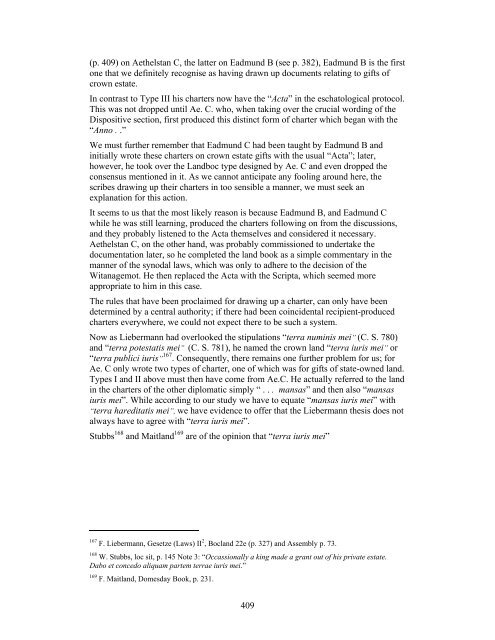Provisional Drogereit pdf
Provisional Drogereit pdf
Provisional Drogereit pdf
You also want an ePaper? Increase the reach of your titles
YUMPU automatically turns print PDFs into web optimized ePapers that Google loves.
(p. 409) on Aethelstan C, the latter on Eadmund B (see p. 382), Eadmund B is the first<br />
one that we definitely recognise as having drawn up documents relating to gifts of<br />
crown estate.<br />
In contrast to Type III his charters now have the “Acta” in the eschatological protocol.<br />
This was not dropped until Ae. C. who, when taking over the crucial wording of the<br />
Dispositive section, first produced this distinct form of charter which began with the<br />
“Anno . .”<br />
We must further remember that Eadmund C had been taught by Eadmund B and<br />
initially wrote these charters on crown estate gifts with the usual “Acta”; later,<br />
however, he took over the Landboc type designed by Ae. C and even dropped the<br />
consensus mentioned in it. As we cannot anticipate any fooling around here, the<br />
scribes drawing up their charters in too sensible a manner, we must seek an<br />
explanation for this action.<br />
It seems to us that the most likely reason is because Eadmund B, and Eadmund C<br />
while he was still learning, produced the charters following on from the discussions,<br />
and they probably listened to the Acta themselves and considered it necessary.<br />
Aethelstan C, on the other hand, was probably commissioned to undertake the<br />
documentation later, so he completed the land book as a simple commentary in the<br />
manner of the synodal laws, which was only to adhere to the decision of the<br />
Witanagemot. He then replaced the Acta with the Scripta, which seemed more<br />
appropriate to him in this case.<br />
The rules that have been proclaimed for drawing up a charter, can only have been<br />
determined by a central authority; if there had been coincidental recipient-produced<br />
charters everywhere, we could not expect there to be such a system.<br />
Now as Liebermann had overlooked the stipulations “terra numinis mei” (C. S. 780)<br />
and “terra potestatis mei” (C. S. 781), he named the crown land “terra iuris mei” or<br />
“terra publici iuris” 167 . Consequently, there remains one further problem for us; for<br />
Ae. C only wrote two types of charter, one of which was for gifts of state-owned land.<br />
Types I and II above must then have come from Ae.C. He actually referred to the land<br />
in the charters of the other diplomatic simply “ . . . mansas” and then also “mansas<br />
iuris mei”. While according to our study we have to equate “mansas iuris mei” with<br />
“terra hareditatis mei”, we have evidence to offer that the Liebermann thesis does not<br />
always have to agree with “terra iuris mei”.<br />
Stubbs 168 and Maitland 169 are of the opinion that “terra iuris mei”<br />
167 F. Liebermann, Gesetze (Laws) II 2 , Bocland 22e (p. 327) and Assembly p. 73.<br />
168 W. Stubbs, loc sit, p. 145 Note 3: “Occassionally a king made a grant out of his private estate.<br />
Dabo et concedo aliquam partem terrae iuris mei.”<br />
169 F. Maitland, Domesday Book, p. 231.<br />
409
















